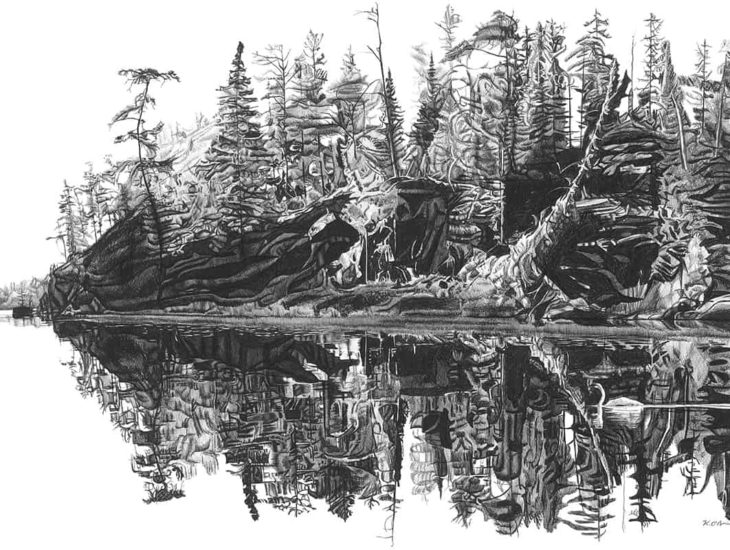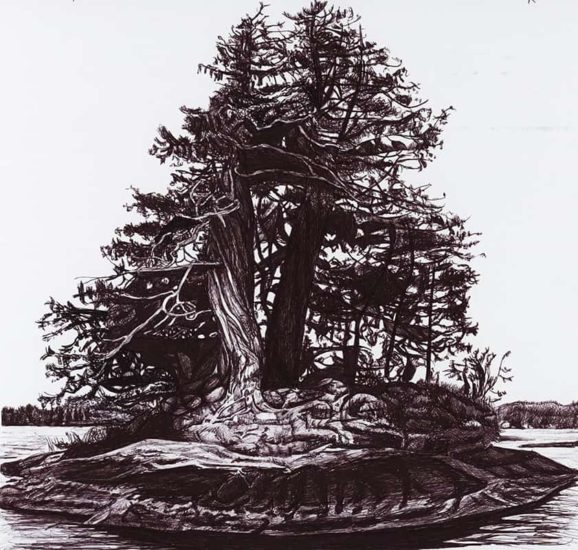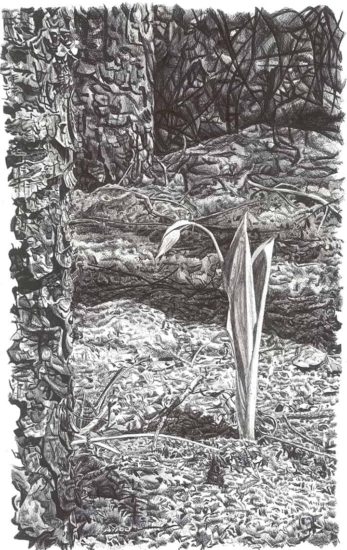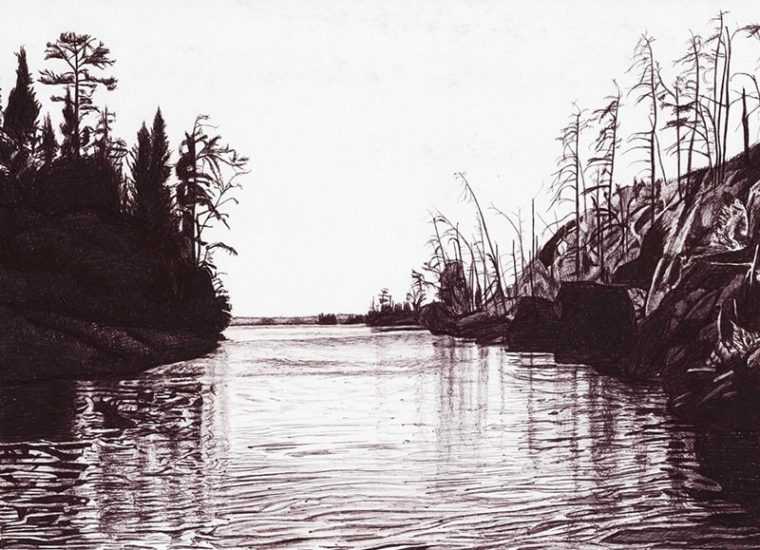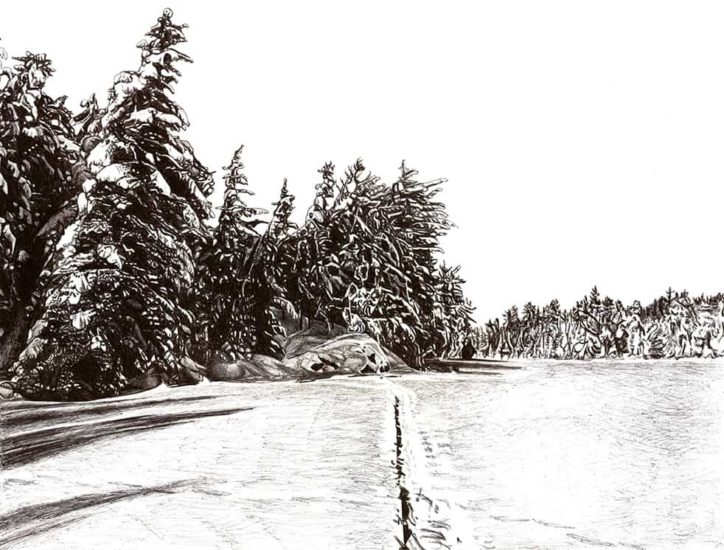Intricate drawings capture pine-studded islands, rare plants on the forest floor, conifers silhouetted against bright sky, the feeling of being mesmerized by light dancing on water. Duluth artist Kelly Beaster shares her work and inspiration with Quetico Superior Wilderness News.
INTERVIEW:
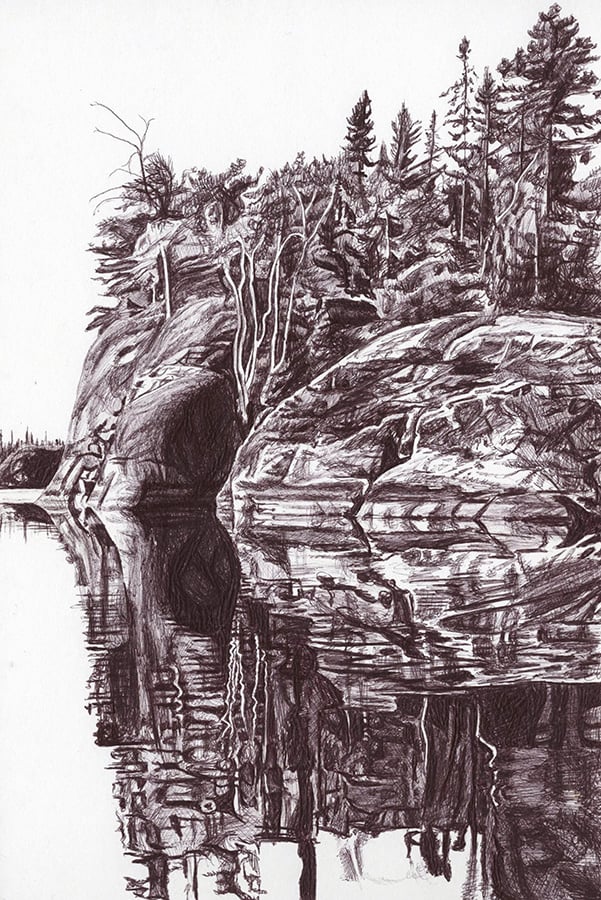
I am a plant ecologist in addition to an artist and as a result I view my surroundings through both those lenses. When I first visited the Boundary Waters, it surpassed all my expectations. Pines towered 100 feet above me, perched atop bedrock cliffs with beds of brittle lichens and soft pine needles at their roots. The intact ecosystems of the border lakes are the closest we can experience to what our northern eco-region historically looked and functioned like.
My first trip into the Boundary Waters wasn’t until I was in my twenties for work when I traveled with my MN Conservation Corps crew. We spent a week camping on an island and restoring a historic conservation officer cabin. I immediately fell in love with the bedrock outcrops, the lowland bogs and black spruce swamps, the winding rivers and deep lakes.
I have taken almost as many winter trips as summer trips, and I appreciate both seasons for different reasons. In the summers, the border lakes are so accessible. We can travel quickly, explore many miles in a day, swim, and eat the landscape: blueberries, thimbleberries, fish. In the winters, everything slows down. Because we cannot travel as quickly, we have the luxury of settling on a lake and exploring the shadows of the trees on the sparkling snow as we stand above our fishing holes in the ice. We trudge through deep snow with snowshoes or skis and glimpse not even an animal, let alone another human. The trees keep us company.
I select images of landscapes that have high contrast and remind me of my time spent in that location. The high contrast works well to depict a mood or emotion. For instance, I drew Gillis Lake because of the calm I feel from the image. My husband and I had done the Frost River Loop quickly and extended it further to add Little Saganaga and some other favorite lakes. By the time we got to Gillis, we were ready to rest. Gillis provided us with calm water, calm weather, and a comfortable campsite.
Sometimes an image of a special place doesn’t turn out, or as in the case of the pictographs I have seen, I don’t feel right about recreating them. But I still want to commemorate my time there somehow. Rather than the pictographs, I drew the trail through the snow on Hegman Lake that highlighted the shapes the trees made draped in inches of powdery snow. I draw a lot of close-up, detailed images because of the textures and shapes that appear.

I create my drawings with a ballpoint pen, and I recycle old matboard cutouts as my drawing paper. It stands up to vigorous shading and travels well. I have drawn on-site, but for my more detailed and larger pieces, I work from a photograph I have taken from my experiences outdoors. While I create each drawing, I get to re-visit past trips and adventures, and I notice things from the drawing itself that I didn’t from the photograph, details that were always there, but the drawing has brought out new details. Each drawing takes between 10 hours for the smaller 9”x12” pieces to 40 hours or more for larger works. I started drawing by focusing on the subjects but now I focus on shapes of shadows, lines, and textures. The switch happened as soon as I picked up the ballpoint pen and left the pencils and erasers behind.
My grandmother gave me a ‘how to draw wildlife book’ when I was 8 years old that included drawings very similar to Francis Lee Jaques. They were high contrast and very detailed. I recreated almost every drawing in that book. That is probably where my drawing style was first influenced. Over the years many artists have influenced my work, including my photography, drawing, and sculpture professors at college. Northern Minnesota produces and attracts a lot of superb artists. I find the paintings Tim Pearson and Howard Siivertson and the macro photography of Travis Novitsky to be inspirational for different reasons. All three artists are great at conveying textures, moods, and compositions.
Where can we see more of your work?
My artwork will be displayed August 2 through September at the Duluth Folk School, highlighting three of Duluth’s trout streams. It is also on display and for sale in the Tuscarora Lodge at the end of the Gunflint, the Big Lake Life in Grand Marais, Two Loons and the Dovetail Café in Duluth.
– Kelly Beaster

See more at her web site here>
All images ©Kelly Beaster


